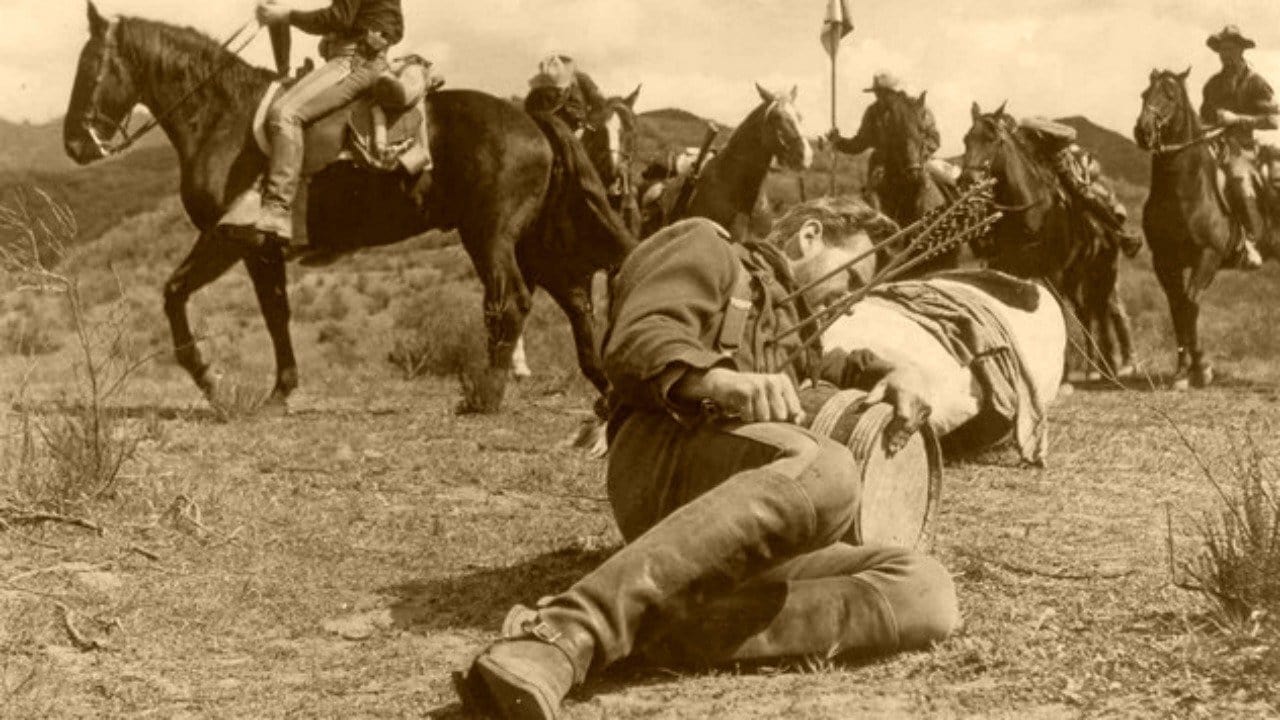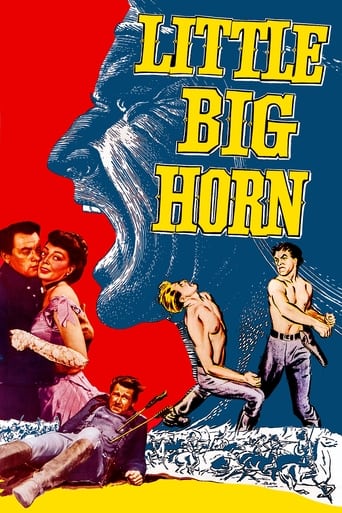



the audience applauded
The performances transcend the film's tropes, grounding it in characters that feel more complete than this subgenre often produces.
View MoreIt's a mild crowd pleaser for people who are exhausted by blockbusters.
View MoreA film of deceptively outspoken contemporary relevance, this is cinema at its most alert, alarming and alive.
View MoreThis was my all time favorite Western. I loved at the end when John Ireland says "Sacrifice a few to save many"..And the bugler says "some on has to lead the charge" with Ireland "make it loud for the one's we left behind. So many great actors in this movie. John Ireland, Lloyd Bridges, Reed Hadley, Hugh O'Brian, Marie Windsor ( she is always great playing the other woman), Sheb Wooley (there was a one eyed one horn flying purple eater) also a regular in "Raw Hide" Jim Davis a another great western cowboy. Another western I enjoyed with John Ireland was "The return of Jessie James" with Reed Hadley as Frank James * Hugh O'Brian and Henry Hull as the Younger brothers.
View MoreThe appearance of "B" movie queen Marie Windsor in the opening scene sets up the feud between two American Army officers (Lloyd Bridges and John Ireland) preparing to go off to warn the unseen General George Armstrong Custer that the battle against the Sioux Indians is a lost cause. She's married to Bridges, but his extended absences have caused her to fall into the arms of Ireland, and when Bridges finds them together, he coldly wishes them well before heading off to possible death. When Ireland shows up leading a troop of messengers, he is forced by Bridges to remain on "just in case" something should happen to him. But is Bridges calculating Ireland's own death with the Sioux tribe having hundreds of scouts out keeping an eye (and even executing) any scout the Americans send out? It certainly seems that way. Individual character elements are added through the tales of various soldiers, including one young man who admits to having a difficult time keeping his food down but insists he isn't afraid of a confrontation with the ruthless Sioux, another one preparing to meet his mail order bride from Canada (which of course ends sadly), the arguments of others (which includes Jim Davis of "Dallas" fame) of Bridges' methods, and finally, how various incidents bring Bridges and Ireland to an understanding if not a peace. This well-made historical western changes the real names of its leading characters (a fact we learn in the film's ending sequence) which makes no sense but provides some insight into why men feel they must go on even if the odds look grim and why others suddenly run away from danger.The excellent performances of the two leads is aided greatly by the ensemble surrounding them. Windsor only has two scenes, the second one a flashback which is basically a re-tread of the opening scene where Bridges discovered her and Ireland together. Bridges' character is as close to a villain as he probably ever played. Even his character in "High Society" (who betrayed old pal Gary Cooper because of his own inner fears) wasn't as dark as this one is. He is even more brooding here than in some of the film noir/crime dramas he was also doing at the time, and he makes every effort to create a very complex man who may or may not be a David plotting to kill his second in command. He's obviously a character who gets the worst kind of personal bad news at the worst possible time, so in heading into an unknown territory of a dangerous wilderness, he seems to feel that he has nothing to lose, even if his soul is in jeopardy. Ireland's character is slightly more noble, and certainly more courageous, because he is aware of what his nemesis may or may not be plotting. One disturbing scene has one of the scouts, injured by a Sioux attack, left to die, and as the troop heads out, a shot of Indians approaching the dying man is shown. A gunshot rings out when the camera cuts back to the troop and they stop only long enough to acknowledge the obvious conclusion. Some of the battles are pretty graphic. Arrows hit in the most obvious painful of places, and one of the characters gets it several times. While they never make it to Custer's Last Stand, this troop is certainly brave in heading that way. In the world of the early 1950's where the future looked grim, the face of courage on screen gave male audiences heart that they could face whatever obstacle America faced with the same grit and determination that got the U.S. out of two world wars with victories both times. On the other hand, you can't help but feel that with natives being bombarded with the white man going west, their own world was changing and they would need to fight to preserve what had long been theirs. So it's a mixed fight overall where truly nobody ended up the winner.
View MoreLittle Big Horn (AKA: The Fighting Seventh) is directed by Charles Marquis Warren who also adapts the screenplay from a story by Harold Shumate. It stars Lloyd Bridges, John Ireland, Marie Windsor, Reed Hadley and Jim Davis. Music is by Paul Dunlap and cinematography by Ernest Miller.A small U.S. Cavalry unit snake their way towards Little Big Horn to warn General Custer of the mortal danger that awaits. But beset with inner conflicts and with the Sioux on their tails, chances of achieving their goal gets slimmer by the hour.Low on budget but big on impact, Little Big Horn may just be the finest film to come out of Lippert Productions. With history as it is, the only thing going against Warren's film is that we know this band of men will not achieve their ultimate goal, but that's OK, for this is not about cheap heroics. Film is very grim, both in texture and thematics. With Warren and Miller painting a stark noir look to the visuals, story unfolds with futility the order of the day.Heading the group are Capt. Phillip Donlin (Bridges) and Lt. John Haywood (Ireland), who we have witnessed at film's beginning forming a messy love triangle with Celie Donlin (Windsor). Captain Donlin is stickler for the rules, but are his motives clouded now? With the rest of the troop believing Haywood is a wife stealer, friction is palpable, yet Haywood keeps proving himself to be an admirable man, consistently doing things to make the troop reevaluate their feelings towards him. The group dynamic set up by Warren is first class, it crackles with intensity.As the journey proceeds a number of potent scenes and scenarios come into play. A man staked up like a scarecrow as a trap, the drawing of cards to see who rides point - which the men know is almost certainly going to result in death - unmarked graves and wedding rings of the dead, these things really strike grim emotional chords. The Sioux are a constant threat out in the rocks or shadows, this troop, as we soon find out, are at the mercy of their better equipped enemy. There's a resignation residing within the group, yet it is that which binds them together. Arrows thud into bodies and blood pours from mouths, and then the finale comes storming in to close down this quite excellent film noir Western.DVD packaged with Rimfire (1949) as a Kit Parker double bill of film noir Westerns, Little Big Horn is very much the better film. Both have the considerable visual skills of Ernest Miller to enjoy, but LBH is the more essential film on account of its across the board excellence. 8/10
View MoreWriting and acting! Acting and writing! Like another great little "Custer" film "Bugles in the Afternoon!" starring Ray Milland (and LBH's Sheb Wooley playing Custer!), the acting and dialog in this Cavalry classic is top notch. Everything just clicks making this film look as good as any classic Western with a much bigger budget.The soundtrack is interesting. The "On the Little Big Horn! 1876!" sung by a chorus rings out loud and clear in the opening credits and sets the mood for the story. Must have been a thrill to the Saturday matinée kid cowboy crowd. It certainly adds to "larger than life" mood of this film.The writers, by setting up this film with the well known history of the Custer defeat (or is it the Native American victory) at the Little Big Horn as a backdrop, helps make your imagination do what the well spent but inexpensive budget doesn't! (It is almost like a radio play in that way.) With the descriptions of sighting of thousands of Souix by the patrols in this film, you feel the intensity and importance of the mission. Also the suspense created by knowing there are a lot of Indians out there and the "Heart of Darkness" atmosphere as the troop advances further and further into Indian territory gives the ambushes that happen the right kind of life and death dynamic. The story line is not that improbable. Gen. Crook, who had met in the Battle of the Rosebud just some of the Souix that would engage Custer a week or so later, did think of continuing with what was left of his command or some troopers to Custer and Terry to inform them of what happened. It didn't happen however. Still, the mission of trying to deliver a message at all costs to Custer gives this film the needed dynamic it requires.Major or soon to be major actors give performances here that both their earlier and later "high budget" careers only enhance. The leads Lloyd Bridges (High Noon!, Sea Hunt, Hot Shots) and John Ireland (Red River, Spartacus, A Walk in the Sun) and supporting actors like the memorable King Donavan (Invasion of the Body Snatchers), the good spirited Wally Cassell (Sands of Iwo Jima), Jim Davis (Dallas!), newcomer Hugh O'Brien (TV's Wyatt Earp), Mr. beautiful baritone Reed Hadley, known for his narrations of Hollywood films (Guadalcanal Diary) and those Atomic Bomb documentaries by the US government plus all the rest of this ensemble do an outstanding job. Bridges and Ireland are perfect as the hard nosed commander and the sympathetic Lt. always in conflict with each other. The film moves along without any real slow spots. It has good cinematography.It has good production values and the good writing that make it seem like a bigger film than it really is. It has that "film noir" mood that never would have worked as well in color either. It is really a western that stimulates your imagination! Many Kudos for this classic!
View More